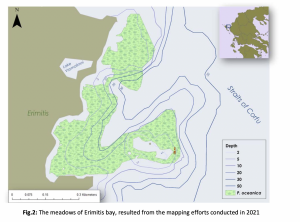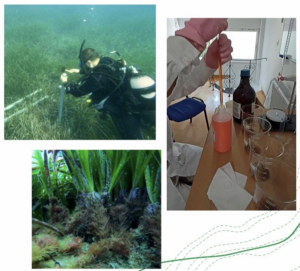iSea’s Report: Quantifying The Blue Carbon Potential of Corfu’s Posidonia Meadows
As part of iSea’s Reposidonia Project, Protecting the Forests of the Sea, important findings for Greece’s blue carbon potential have been reported following the completion of a study launched earlier this year.
A mapping and observation survey last year along the coast of NE Corfu indicated an ‘almost pristine environment’. Further research was deemed necessary in order to evaluate the health of the meadow and to quantify the potential of its blue carbon store. For this reason the team visited the site for a third time in February 2022 to collect root density data as well as leaf and sediment samples. The samples were analysed and the report created and submitted earlier this month.
Context:
The Erimitis peninsula is located in the Straits of Corfu, a narrow body of water between the coasts of Albania and Greece (Northeast Corfu), that separates the two countries. The channel is a passage stretching from the Adriatic Sea in the north to the Ionian Sea. The mainland area across the channel from Erimitis shores is the Butrinti National Park, an UNESCO World Heritage Site.
The study area has a total surface of 25.4 hectares with a maximum depth of 43 meters and is characterized by an extended rocky shore, with isolated small sandy beaches.
Neptune’s grass (Posidonia oceanica) is a seagrass endemic to the Mediterranean Sea, creating underwater “forests” that constitute the most important and productive marine habitat in the basin. Additionally, Posidonia meadows, are among the most important blue carbon sinks globally playing a crucial role in fighting climate crisis. Due to its importance and the threats it faces as a result of a variety of human activities, it is protected by EU and international conventions. However, Posidonia meadows’ regression is an extended phenomenon throughout the Mediterranean primarily due to coastal development and uncontrolled anchorage.

Findings:
The amount of organic carbon stored in the meadows assessed by this study shows that Erimitis’ substrate stocked 563.85 tonnes of organic blue carbon – the equivalent of 140 elephants! It is important to mention that this amount does not include the entire possible depth of the substrate, which might include additional quantities of accumulated carbon (from 60‐100cm). Also, the meadows of the study area extend outside the mapped area, and spread from its northern and southern boundaries. These meadows are not mapped, and no estimation of their blue carbon stock can be made. The indication from this study therefore suggests the whole region is rich in blue carbon and as such forms a vital carbon sink for the Mediterranean…and the planet!
Conclusion:
The study found that the area consists of a rich blue carbon sink in an ‘almost pristine’ healthy and undisturbed meadow, hosting a high number of different species – 107 aquatic species were identified during the biodiversity monitoring.
Since Posidonia meadows are characterized as being one of the most productive ecosystems in the Mediterranean, and this research also quantifies their importance as a blue carbon store, it becomes apparent that the protection of Erimitis bay and the management of its threats and disturbances should be highly prioritised.
These significant results serve to increase the scientific knowledge about the blue carbon potential, the distribution, the coverage, the biodiversity and the health of these meadows . The results aim to educate and inform decision-makers responsible for targeted marine management actions for this region.
To download and read the full report click HERE

